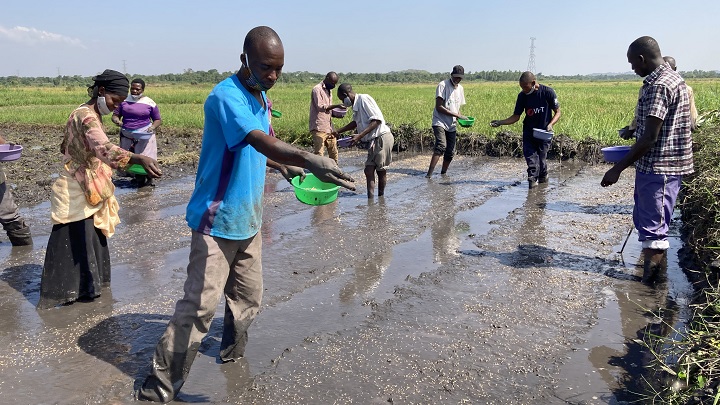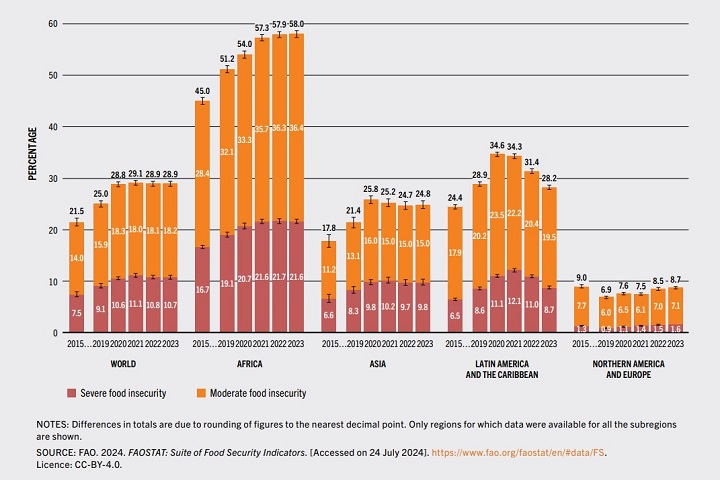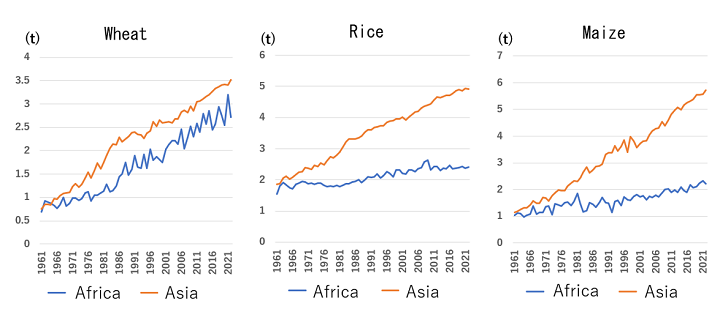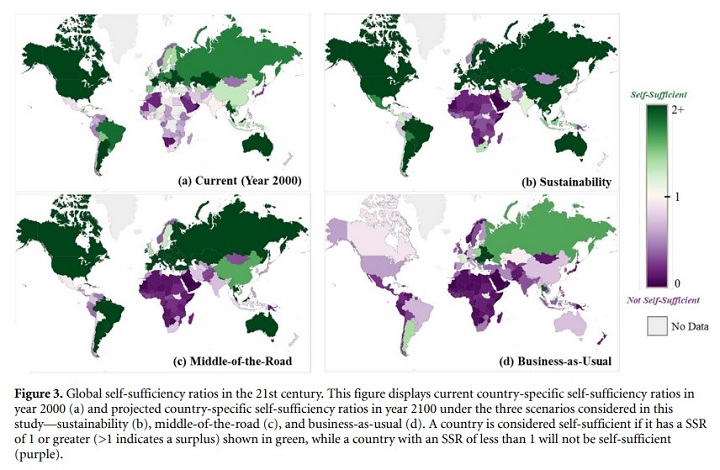Blog “Food Security and Agricultural Development in Light of Africa’s Development”
2025.01.27
Researchers at the JICA Ogata Sadako Research Institute for Peace and Development (JICA Ogata Research Institute) have wide-ranging experience and diverse backgrounds, and they are forging partnerships with varied stakeholders and partners. This series of blog posts shares the knowledge and perspectives that they have acquired through their research activities. This blog post was written by Amameishi Shinjiro, Executive Senior Research Fellow, who is working on research on agricultural development in Africa.

Author: Amameishi Shinjiro, Executive Senior Research Fellow, the JICA Ogata Research Institute
There are longstanding challenges around food security and agricultural development in Africa. Since 2000, the African continent has shifted to the stage of economic development and many socioeconomic indicators are suggesting improvement. However, substantial progress has not been seen yet for food security and agricultural development, and it is worried that the situation may worsen in the future. Because of such vulnerability, a drought is making nearly 27 million people starve and 21 million children suffer from malnutrition in southern parts of Africa, as of November 2024. The World Food Programme (WFP) is calling for emergency assistance (WFP website). Not only African countries but also development partners including JICA must collaborate to address challenges around food security and agricultural development with great priority.
Each blog post in this series will discuss Africa’s healthy development through food security and agricultural development from a different perspective in the following order: (1) future food security; (2) employment creation for younger generations; and (3) gender equality and the empowerment of women in rural areas.
This is the first post in this series and will look at future food security.
In Africa, the malnourished population was generally declining from 2000 onward but started to increase again from 2014. Today, nearly 60% of the African people still face moderate to extreme food insecurity (Fig. 1: FAO, IFAD, WFP, UNICEF, WHO, 2024). Although Asia currently has the largest malnourished population in the world (in total), Africa seems set to surpass Asia in the near future.

Fig. 1: Change in the percentage of population experiencing food insecurity over the years by region
Source: FAO, IFAD, UNICEF, WFP, WHO (2024)
Asia and Africa once both faced food scarcity. Back in 1960, Asia and Africa did not show much difference in the yields of major grains but from the late 1960s, Asia saw a significant boost in the yields and production of grains, mainly rice and wheat. This was achieved by the Green Revolution, which developed and introduced improved varieties as well as spreading appropriate cultivation technologies. In Asian countries, the introduction of newly developed varieties that had better yields and disease resistance was successful, along with the spread of cultivation technology. Meanwhile, yield growth was not sufficient in Africa. Yields of maize (corn), which is the staple food in many African countries, and rice, which is seeing a huge growth in demand over recent years due to economic development, are less compared to Asia (Fig. 2).

Fig. 2: Yield change for major grains over the years in Africa and Asia
Source: Data from FAOSTAT
As the environment for agriculture including precipitation and soil fertility is restricted in Africa, many countries in the region rely on imported food. Africa’s dependency on imported grains is as high as 30.6% for 2018–2020 and generally continues to rise (FAO, 2023). In recent years, food price soared globally because of the disruption of food supply chains and markets caused by the COVID-19 pandemic (from 2020) and the Russian invasion of Ukraine (from 2022). Being highly dependent on imported food, Sub-Saharan Africa (SSA) was particularly affected. Between 2020 and 2022, the average increase in the price of staple food was 23.9% (IMF blog post), and in 2022, there was great concern about an African food crisis. With recovery in grain export from Ukraine since then, today, the situation is not as critical. Yet still, the African food situation remains vulnerable. Food insecurity remains a critical issue in Africa.
When considering future food security in Africa, the first concern is population growth. The United Nations predicts that the SSA population will nearly double from 1.152 billion to 2.094 billion between 2022 and 2050. More than half of the global population growth within this timeframe is expected to take place in SSA (UN Department of Economic and Social Affairs, 2022). FAO (2017) pointed out that to meet the food demand in Africa and South Asia in 2050, agricultural production in these two regions must be at least doubled from 2005/2007.
Another concern is the impact of climate change. The effects of global warming on agricultural production may be positive in some high-latitude areas, but extremely negative in low-latitude areas like SSA, where agricultural production is predicted to become seriously impacted by extreme weather like droughts, changes in precipitation patterns, less precipitation and floods. Furthermore, increased food diversity brought about by economic development may also have an impact. Following economic development, the number of middle-class and wealthy people is on the rise in Africa. In Asia, demand for meat and dairy products that require grain feed for production is growing following economic development and the trend of increased food diversity may become more apparent in Africa as well.
How is the food situation in Africa going to look like in the future then? Beltran-Peña et al (2020) evaluated the global food self-sufficiency as of 2100. Three factors that significantly impact the future food situation were identified: i) impacts of climate change; ii) diets with animal calorie; and iii) population change. Three scenarios around these factors were analyzed. Under the sustainability scenario, they paired low climate change scenario, diets with low animal-calorie shares, and the low population variant. Under the business-as-usual-scenario, they paired the high climate change scenario, diets with high animal-calorie shares, and the high population variant. The middle-of the-road scenario paired moderate climate change scenario with moderate diets, and the medium population variant. The “middle-of-the-road” scenario combined moderate climate change, moderate-animal-calorie diets and a medium population variant. All three scenarios projected that Africa will fail to be self-sufficient and the food situation will become worse than it is today (Fig. 3). There are serious concerns that the African food situation could fall into a crisis in the future. Necessary measures from medium- to long-term perspectives need to be taken.

Fig.3: Self-sufficiency today and in 2100
Source: Beltran-Peña et al (2020)
African countries must focus on agricultural development and give maximum priority to increasing agricultural production. The African Union (AU) sets a goal to have each African government allocate a minimum of 10% of its national budget to the agricultural sector, but the average allocation rate remains at a mere 2.55% as of 2020 (FAOSTAT). This is merely less than one-fifth of the budget for the education sector and less than a half of the budget for the health sector. The scarcity of funding is obvious, given that 10% of national budgets were allocated to agricultural sectors in East Asia (including present Southeast Asia) during the Green Revolution in the early 1980s (World Bank, 2020). In particular, the shortage of funding for agricultural extension and research is affecting agricultural production. When sufficient budget is allocated to agricultural extension, more effective and appropriate cultivation technologies can be spread. Agricultural research provides high returns on investments. Although agricultural research is particularly effective in promoting sustainable agricultural growth and alleviating poverty (FAO website), budgets for agricultural research are extremely limited in African nations. The AU’s goal to make expenditure for agricultural research to be equivalent to 1% of the GDP has been reached by only eight member states. With external assistance, continued efforts for research and development, as well as agricultural extension, are needed (AU and AUDA-NEPAD 2024).
JICA has been conducting a wide range of cooperation activities to strengthen food security in Africa, and one of its flagship initiatives is the Coalition for African Rice Development (CARD), which aims to double rice production in Africa. CARD was launched in 2008 mainly by JICA and the Alliance for a Green Revolution in Africa (AGRA). Today, CARD has grown into an international initiative of 19 partner organizations and targets a total of 32 African countries. CARD develops and spreads appropriate rice-cultivation technologies in various African countries and the effectiveness of its efforts has been demonstrated by academic research. At the JICA Ogata Research Institute, an empirical analysis of CARD, led by Otsuka Keijiro, Distinguished Honorary Professor, Kobe University, has been ongoing since 2009. (See the CARD research website
for details.) From the research work conducted to date, the effectiveness of various efforts has been shown such as the following:
・Rice-farming training has important and long-lasting effects on yield;
・Effects spill over from farmers who have received training to their neighboring farmers;
・Introduction of power tillers contributes to improved yield and production-scale expansion;
・Introduction of improved rice-milling machines leads to achieving high-quality rice milling that gives African rice competitiveness against imported rice as well as to improving the business performance of rice millers.
The big challenge lies with how to leverage research outcomes to activities on the ground.
There is no time to lose for African food security. The momentum for development partners, the private sector and research institutes to collaborate and work on food security as a priority issue with a long-term perspective, under the leadership of African countries, needs to be built.
FAO Website: Overview | Research and Extension Systems | Food and Agriculture Organization of the United Nations
IMF Blog “Africa Food Prices are soaring amid high import reliance”
WFP Website “Emergency: Southern Africa drought
”
African Union (AU) and African Union Development Agency (AUDA-NEPAD). 2024. 4th CAADP Biennial Review Report 2015-2023.
Beltran-Peña, Areidy, Lorenzo Rosa and Paolo D’Odorico. 2020. “Global food self-sufficiency in the 21st century under sustainable intensification of agriculture” Environmental Research Letters 15 (2020) 095004
FAO. 2017. The future of food and agriculture: Trends and challenges
FAO. 2023. FAO Statistical Yearbook World Food and Agriculture 2023
FAO, IFAD, UNICEF, WFP, WHO. 2024. The State of Food Security and Nutrition in the World: Financing to End Hunger, Food Insecurity and Malnutrition in All its Forms
UN Department of Economic and Social Affairs. 2022. World Population Prospects 2022
WB. 2020. Agriculture, Jobs and Value Chain in Africa. Jobs Note issue No.9
Disclaimer: All opinions expressed in this blog post are the author’s and do not reflect opinions of JICA or the JICA Ogata Research Institute.
Amameishi Shinjiro
Amameishi is an Executive Senior Research Fellow at the JICA Ogata Research Institute since 2023. He joined JICA in 1994 and after serving as a Project Expert (Laos), he worked at the following: the Regional Office for Asia and the Pacific, Food and Agriculture Organization of the United Nations (FAO); Rural Development Department, JICA; JICA Tanzania Office; JICA Kenya Office; and the Economic Development Department, JICA. Amameishi’s main research areas include agricultural development, agricultural policy, participatory development and aid coordination in Africa.


事業事前評価表(地球規模課題対応国際科学技術協力(SATREPS)).国際協力機構 地球環境部 . 防災第一チーム. 1.案件名.国 名: フィリピン共和国.

事業事前評価表(地球規模課題対応国際科学技術協力(SATREPS)).国際協力機構 地球環境部 . 防災第一チーム. 1.案件名.国 名: フィリピン共和国.

事業事前評価表(地球規模課題対応国際科学技術協力(SATREPS)).国際協力機構 地球環境部 . 防災第一チーム. 1.案件名.国 名: フィリピン共和国.

事業事前評価表(地球規模課題対応国際科学技術協力(SATREPS)).国際協力機構 地球環境部 . 防災第一チーム. 1.案件名.国 名: フィリピン共和国.

事業事前評価表(地球規模課題対応国際科学技術協力(SATREPS)).国際協力機構 地球環境部 . 防災第一チーム. 1.案件名.国 名: フィリピン共和国.
scroll